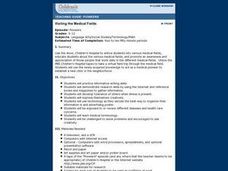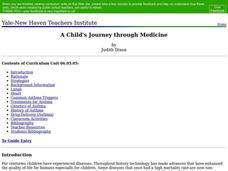National Association of School Nurses
Be Safe and Smart with Medicine
Start youngsters off on the right track when it comes to medicine awareness. Learners becomes familiar with the right and wrong ways to use medicines and even find out where the school nurses office is. They also identify safe people to...
Curated OER
Medicine
Go over the importance of staying safe when handling or coming into contact with medicine. This very short presentation covers some of the key dangers and reasons why children should be careful around prescription drugs.
Generation Rx
Medication Safety Patrol: Is It Candy or Medicine? Game
Scholars play a sorting game designed to encourage safe medication handling. They browse pictures of candy and medication, then decide which of the two they're looking at by raising a card labeled candy or medicine.
Curated OER
Candy or Medicine
Students compare and contrast the appearance of medicine and candy to demonstrate the need for safety precautions with medicines, and adult supervision.
Curated OER
Saying No To Harmful Medicines
First graders practice saying "no" in different ways to respond to taking harmful medicines. In this saying "no" lesson plan, 1st graders read the story "Green Eggs and Ham" and talk about saying "no". Then they discuss the different...
Curated OER
Medicine safety
Students identify reasons why people take medicines. In this medicine lesson plan, students are shown different medicines and discuss why people might take them. The teacher poses different scenarios about when it is safe and unsafe to...
Curated OER
Health Grade 1
First graders determine the difference between good and bad drugs. In this lesson about drug awareness, 1st graders explore differences between drugs. Students will look at picture and understand what uses there are for drugs. Students...
Curated OER
You Can't Tell by Looking
Students examine why medicines must be used correctly and the risks of confusing medicine with candy. They answer discussion questions, identify rules for taking medicine, analyze the similarities between candy and medicine, and create a...
Curated OER
What About Health?
Students examine the concepts of healthy and unhealthy drugs. They read and discuss excerpts from the book "The Human Body," develop a list of healthy and unhealthy drugs, and write sentences relating to safety about medicines and other...
Curated OER
Visiting the Medical Fields
Students act as medical pioneers to establish a clinic in an under served area.t They work in teams of two to complete a portfolio about their clinic and examine new treatments in various area of medicine.
PBS
Stories of Painkiller Addiction: Myth or Fact
Are opioids the most abused drug after marijuana? How hard is it for young people to obtain painkillers without a prescription? Middle and high schoolers explore the growing epidemic of opioid addiction with a lesson that prompts them to...
National First Ladies' Library
Leeches and Spiders and Toads, Oh, My! The Emergence of Modern Medicine
Learners explore the basic ideas and beliefs about medicine in the 18th and 19th centuries. They write a news account to be published in a "medical journal" developed by the class. Each "article" in the journal should be dated...
Curated OER
Safe ways to take medicine
Students match who to contact if they need help in certain situations and discuss safety with medicines. In this medicine lesson plan, students match the person who can help them take medicine safely. They also participate in a...
Curated OER
A Child's Journey through Medicine
Students experience a variety of activities that relate to human physiology and their functions. They create graphs and charts after testing their heart rates and blood pressure They conduct a survey of the student body and create ...
Baylor College
How Do We Use Water?
Send youngsters home to survey how they use water in their homes. Then bring them together to discuss which uses are essential for our health and which are not. A helpful video offers teaching tips for this lesson, and a presentation...
Baylor College
Food for the Brain
With a couple of neat diagrams on student handouts, your life science or health class will examine the contents and serving sizes of healthy foods. They dissect a slice of pizza and scrutinize the nutritional value of its components in...
Baylor College
Food: The Math Link
Enrich your study of food science with with these math worksheets. They offer a variety of food-related word problems that are great practice for multiplying, identifying fractions, estimating length, and performing calculations with...
Curated OER
Health Dialogue
In this health dialogue worksheet, students answer discussion questions about health care.
Curated OER
Nutrition Decision
High schoolers act as decision makers and research and determine the nutritional needs of young children, teenagers, and adults. They compile their findings in a nutrition portfolio. Class groups assume the role of hospital dietician and...
Baylor College
Measuring and Protecting Skin
Several subjects are addressed within the context of a science lesson about the sun's ultraviolet rays. Elementary earth scientists consider protection of the skin with sunscreens (health), estimating and measuring surface area or an...
Baylor College
Crossing the Synaptic Gap
As part of a unit on the chemistry of the brain, thinkers learn how chemicals work to transmit messages between individual neurons and how controlled substances impact the synaptic cleft. They do so by playing a dice-and-card game in...
Baylor College
Drugs, Risks and the Nervous System
In cooperative groups, middle schoolers contemplate the probability of 18 different situations occurring. After they make predictions, they compare them to the actual risk factors. This eye-opening exercise demonstrates that the odds of...
Baylor College
Infectious Disease Case Study
Small groups of life science learners look at Allison's symptoms and discuss a diagnosis. They use a chart of illnesses and draw symptom clues from an envelope to determine what illness she has. A lesson like this gives children an...
Curated OER
BELT-ABOUTS LESSON 2
Pupils explain why safety belts don't fit all children. They decribe the correct way to wear a safety belt. Students explain why incorrect belt fit can be dangerous. They are shown a diagram of the human body. Pupils identify the...

























